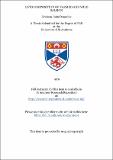Files in this item
Lipid composition of farmed and wild salmon
Item metadata
| dc.contributor.advisor | Gunstone, F. D. | |
| dc.contributor.author | Donachie, Graham John | |
| dc.coverage.spatial | 1979 | en_US |
| dc.date.accessioned | 2018-07-04T09:44:22Z | |
| dc.date.available | 2018-07-04T09:44:22Z | |
| dc.date.issued | 1979 | |
| dc.identifier.uri | https://hdl.handle.net/10023/14901 | |
| dc.description.abstract | The lipid composition in terms of component lipids and component acids - of farmed and wild Atlantic salmon (Salmo salar) was studied at various stages of their life cycle, up to and including sexual maturation. Lipids were extracted separately from flesh, liver and gonad organs for this study. The majority of samples examined in this work were from farmed salmon and to determine the influence of the diet on their lipid composition, a sample of the diet fed to farmed salmon was extracted and its lipids analysed. The dietary lipid is composed mainly of neutral lipids, particularly triacylglycerols, with minor amounts of polar lipids (phosphatidyl choline, phosphatidyl ethanolamine, phosphatidyl inositol and cardiolipin).The fatty acid composition of the dietary lipid components suggested that the dietary lipid was a mixture of vegetable oils, seed oils and. fish meal(s).The major neutral lipids of salmon tissues were triacyl-glycerols, cholesterol and cholesterol esters while the dominant polar lipids were phosphatidyl choline and phosphatidyl ethanolamine, with smaller amounts of cardiolipin, phosphatidyl inositol, phosphatidyl serine and spingomyelin. The major fatty acids present in all samples examined included saturated acids (mainly 16:0 accompanied by 14:0 and 18:0), monoene acids (16:1, 18:1 and 20:1, with lower levels of 22:1 and 24:1), the n-6 group of acids, of which only 18:2 and 20:4 are consistently noticeable, and, at a much higher level, the n-3 group of acids with 22:6 > 20:5 > 22:5 >> other members. Neutral lipids (mainly TG) were highest in the flesh and least in the liver where correspondingly polar lipids (PC and PE) were highest. Variations occurred in fatty acid composition in relation to lipid class and lipid site (flesh, liver and gonads). Phosphatidyl cholines had the highest proportion of saturated acids at all three sites, whereas triacylglycerols had the highest monoene and n-6 polyene acid content. The phospholipids had very high levels of n-3 polyene acids at all three sites, whereas triacylglycerols had lower levels of these acids, although the difference was less marked in the gonads. The total lipid levels and the lipid class composition of farmed and wild salmon, all of which had spent twelve months in sea water, differed only in the gonads, where the amount of lipid in the wild salmon was greatly increased. This was reflected in a higher proportion of triacylglycerols present in the wild salmon. The major difference between the fatty acid composition of farmed and wild salmon was the higher concentration of linoleic acid in the farmed salmon triacylglycerols from all three sites compared to wild salmon triacylglycerols. This was attributed to the higher linoleic acid content in the diet of farmed salmon compared to that present in the natural marine diet. With maturation there was a decrease in the total lipid content of flesh, little change in the liver, and an increase for the gonads. The proportion of neutral lipids decreasedupon maturation, at all three sites. During the period up to and including maturation, there appeared to be selective mobilisation of the fatty acids of hepatic polar lipids, and C₁₆ and C₁₈ saturated and monoenoic acids increasing while the C₂₀ and C₂₂n-3 polyenoic acids (particularly 22:6) decreased. In the gonadal phosphatidyl cholines, maturation was accompanied by an increase in the C₂₀ and C₂₂n-3 polyenoic acids and a decrease in the saturated and monoenoic C₁₆ and C ₁₈ acids. No significant individual differences were observed in either total lipid levels or lipid composition in the flesh and liver of a group of male and female farmed salmon which originated from the same sea water pen, and had been fed the same diet. | en_US |
| dc.language.iso | en | en_US |
| dc.publisher | University of St Andrews | |
| dc.subject.lcc | QD305.F2D7 | |
| dc.subject.lcsh | Lipids | en |
| dc.title | Lipid composition of farmed and wild salmon | en_US |
| dc.type | Thesis | en_US |
| dc.contributor.sponsor | Science Research Council (Great Britain) | en_US |
| dc.type.qualificationlevel | Doctoral | en_US |
| dc.type.qualificationname | PhD Doctor of Philosophy | en_US |
| dc.publisher.institution | The University of St Andrews | en_US |
This item appears in the following Collection(s)
Items in the St Andrews Research Repository are protected by copyright, with all rights reserved, unless otherwise indicated.

